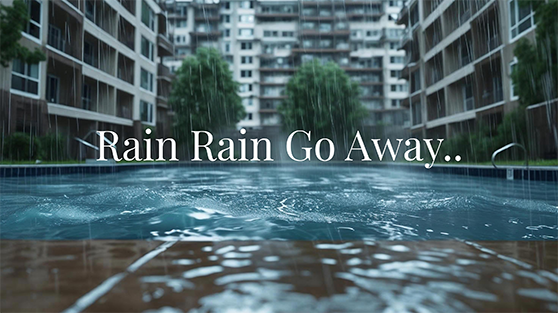Rain can be a welcome relief on a hot day, but for pool owners, it often brings a new set of challenges. From murky water to overflowing skimmers, maintaining your swimming pool during rainy weather requires a little extra TLC. Here’s a humanized, data-driven guide—complete with real-life examples and actionable tips—to help you keep your pool sparkling, even when the skies open up.
Why Rain Affects Your Pool
Rainwater isn’t just H₂O—it’s slightly acidic and often carries airborne debris, pollen, and even algae spores. A single heavy storm can drastically lower your pool’s pH, dilute chlorine, and introduce contaminants, leading to cloudy water or even a green pool if left unchecked.
Real-Life Example
Last summer, the Johnson family in Atlanta noticed their pool turned cloudy after a week of afternoon thunderstorms. Their water level rose above the skimmer, and leaves from nearby trees collected on the surface. Within days, algae started to bloom. With a few simple steps, they brought their pool back to life—and you can too.
Essential Pool Maintenance Tips During Rain
-
Monitor and Adjust Water Levels
-
Rain can quickly raise your pool’s water level, making skimmers ineffective. After a storm, check that the water sits halfway up the skimmer opening. If it’s too high, drain the excess using your filter’s “waste” setting, a submersible pump, or even a siphon hose.
-
Pro tip: Don’t let the water drop below the skimmer—this can damage your pump.
-
-
Test and Balance Pool Chemistry
-
Rain dilutes chlorine and lowers pH, making the water more hospitable to algae. Test your pool’s pH, alkalinity, and chlorine after each rain. The ideal pH is 7.4–7.6, and free chlorine should be 1–3 ppm.
-
Data point: According to pool care experts, 70% of post-storm algae outbreaks are due to unbalanced water chemistry.
-
-
Remove Debris Promptly
-
Use a skimmer net to clear leaves, twigs, and other debris before they sink. Clean out skimmer baskets and check the pump basket to keep water flowing smoothly.
-
Real-life tip: The Johnsons found that skimming twice a day during rainy weeks prevented most debris from clogging their filter.
-
-
Brush and Vacuum the Pool
-
Brush walls and steps to dislodge algae spores and dirt. Vacuum the floor to remove fine debris that settles after a storm.
-
Example: After a windy rainstorm, a pool owner in Phoenix spent 20 minutes brushing and vacuuming, avoiding a green pool the next day.
-
-
Shock the Pool
-
Heavy rain can overwhelm your sanitizer. “Shocking” means adding a high dose of chlorine to kill bacteria and algae. Do this at night so the sun doesn’t burn off the chlorine too quickly.
-
Tip: Always adjust pH before shocking for best results.
-
-
Run the Filter Longer
-
After rain, run your filter for 12–24 hours to clear out contaminants and circulate chemicals evenly.
-
-
Consider a Pool Cover
-
A weatherproof pool cover can prevent up to 90% of debris from entering your pool during storms, saving hours of cleanup.
-
Material tip: Mesh covers allow rain to pass through but keep leaves out—perfect for rainy climates.
-
What To Do After It Rains
-
Skim and remove debris
-
Clean skimmer and pump baskets
-
Test and adjust water chemistry (pH, chlorine, alkalinity)
-
Brush and vacuum pool surfaces
-
Lower water level if needed
-
Shock the pool if water is cloudy or green
-
Run the filter for an extended period






